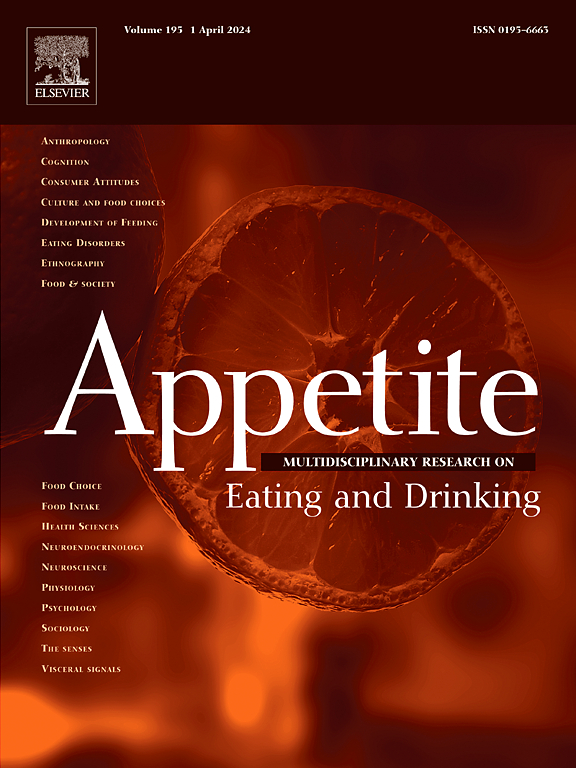感知食物价值取决于展示形式、偏好强度和物理可及性。
IF 4.6
2区 医学
Q1 BEHAVIORAL SCIENCES
引用次数: 0
摘要
在日常生活中,饮食决定是根据真正的食物做出的,比如在杂货店或咖啡馆。与之形成鲜明对比的是,实验室中的决策研究通常会测量人们对以二维图片或计算机图像呈现的食物刺激的反应,并假设人工展示足以替代现实世界中的食物刺激。然而,越来越多的证据挑战了这一观点,包括研究表明,作为实物展示的食物比图像展示的食物更愿意支付(WTP),这一现象在估值中被称为“实物优势”。在这里,我们研究了“真实物体优势”是否受到刺激物的可及性、主观食物偏好或这些因素之间的相互作用的调节。参与者对显示为实物或电脑图像的零食进行金钱竞标。关键的是,在一半的试验中,参与者和刺激物之间放置了一个透明的屏障。线性混合效应建模分析显示,总体而言,作为真实物体展示的食物的WTP比图像高约7%;然而,这种效应只出现在中等(而不是强烈)偏好强度的食物上。当刺激未被排除时,WTP也高于屏障后的WTP,但对于真实物体和图像也是如此,这表明屏障对评估的影响与刺激的可操作性无关。我们的研究结果表明,尽管消除对商品的感知障碍可以提高价值,而不管展示形式如何,展示真实的食品可能会提高价值,并鼓励健康的饮食选择。本文章由计算机程序翻译,如有差异,请以英文原文为准。
Perceived food value depends on display format, preference strength, and physical accessibility
In everyday life, dietary decisions are made in response to real foods, such as at the grocery store or cafe. In stark contrast, decision-making studies in the laboratory typically measure responses to food stimuli presented as two-dimensional pictures or computer images, with the assumption that artificial displays are adequate substitutes for their real-world counterparts. Yet accumulating evidence challenges this view, including studies showing that willingness-to-pay (WTP) is higher for foods displayed as real objects versus images –a phenomenon known as the “real object advantage” in valuation. Here, we examined whether the “real object advantage” is modulated by accessibility to the stimuli, subjective food preference, or interactions between these factors. Participants placed monetary bids on snack foods displayed as real objects or computer images. Critically, on half of the trials, a transparent barrier was positioned between the participant and the stimulus. Linear mixed-effects modeling analysis revealed that, overall, WTP was ∼7 % higher for foods displayed as real objects versus images; however, this effect emerged only for foods of moderate (but not strong) preference strength. WTP was also higher when the stimuli appeared unoccluded versus behind the barrier, but this was equally so for real objects and images, suggesting that the barrier's effect on valuation was not related to stimulus actability. Our findings suggest that while eliminating perceived barriers to a good can bolster valuation regardless of display format, presenting real foods may nevertheless increase valuation and encourage healthy dietary choices.
求助全文
通过发布文献求助,成功后即可免费获取论文全文。
去求助
来源期刊

Appetite
医学-行为科学
CiteScore
9.10
自引率
11.10%
发文量
566
审稿时长
13.4 weeks
期刊介绍:
Appetite is an international research journal specializing in cultural, social, psychological, sensory and physiological influences on the selection and intake of foods and drinks. It covers normal and disordered eating and drinking and welcomes studies of both human and non-human animal behaviour toward food. Appetite publishes research reports, reviews and commentaries. Thematic special issues appear regularly. From time to time the journal carries abstracts from professional meetings. Submissions to Appetite are expected to be based primarily on observations directly related to the selection and intake of foods and drinks; papers that are primarily focused on topics such as nutrition or obesity will not be considered unless they specifically make a novel scientific contribution to the understanding of appetite in line with the journal's aims and scope.
 求助内容:
求助内容: 应助结果提醒方式:
应助结果提醒方式:


